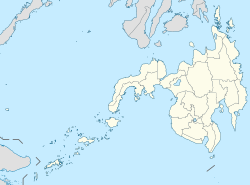Sanga-Sanga Airport Lapagan sin Sanga-Sanga Paliparan ng Sanga-Sanga | |||||||||||
|---|---|---|---|---|---|---|---|---|---|---|---|
 A view of Sanga-Sanga Airport from the peak of Mount Bongao. | |||||||||||
| Summary | |||||||||||
| Airport type | Public | ||||||||||
| Owner/Operator |
| ||||||||||
| Serves | Tawi-Tawi | ||||||||||
| Location | Sanga-Sanga, Bongao, Tawi-Tawi, Philippines | ||||||||||
| Elevation AMSL | 2 m / 7 ft | ||||||||||
| Coordinates | 05°02′49″N119°44′34″E / 5.04694°N 119.74278°E | ||||||||||
| Map | |||||||||||
 | |||||||||||
| Runways | |||||||||||
| |||||||||||
| Statistics (2022) | |||||||||||
| |||||||||||
Statistics from the Air Transportation Office. [2] | |||||||||||
Sanga-Sanga Airport( IATA : TWT, ICAO : RPMN), also known as Tawi-Tawi Airport, is an airport serving the general area of Bongao, the capital of the province of Tawi-Tawi in the Philippines. The airport is classified as a Class 2 principal (minor domestic) airport by the Civil Aviation Authority of the Philippines. It is not an international airport, contrary to its classification by the Tawi-Tawi provincial government. It is located in Sanga-Sanga Island. The airport was formerly referred by the IATA with the code SGS until the end of 2011, when its IATA code was finally changed to TWT.
Contents
In 2005, the runway was extended to 1,860 meters through partnerships between the Department of Transportation and Communications (DOTC, today the DOTr), the CAAP, the United States Agency for International Development (USAID), the regional government of the Autonomous Region in Muslim Mindanao and the Tawi-Tawi provincial government. In addition, the runway has been widened to 30 meters. Along with the expansion of Jolo Airport in Sulu, the expansion of the runway was completed in August 2009. [3]
The new runway was officially inaugurated on August 17, 2009 by US ambassador Kristie Kenney and local officials in Tawi-Tawi. [4]
In 2015, the DOTC allotted Php248 million to jumpstart the renovation of the Sanga-Sanga Airport and an additional Php10 million for the fencing requirement expenses of the Cagayan de Sulu Airport in the Municipality of Mapun, Tawi-Tawi. The DOTC was also to release another Php577 million by January 2016 to finance the further improvement and development of the Sanga-Sanga Airport. [5]

